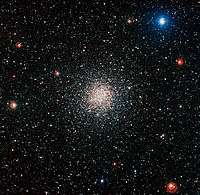NGC 6362
| NGC 6362 | |
|---|---|
|
NGC 6362 | |
| Observation data (J2000 epoch) | |
| Class | X[1] |
| Constellation | Ara |
| Right ascension | 17h 31m 54.99s[2] |
| Declination | –67° 02′ 54.0″[2] |
| Distance | 24.8 kly (7.6 kpc)[3] |
| Apparent magnitude (V) | +8.3[4] |
| Apparent dimensions (V) | 9' |
| Physical characteristics | |
| Metallicity | = –0.99[5] dex |
| Estimated age | 13.57 Gyr[5] |
NGC 6362 is a globular cluster in the constellation Ara, lying close to Apus in the southern sky. A telescope with a 150mm primary mirror is required to resolve the stars within this irregularly shaped cluster.[4] The cluster NGC 6362, what's known as a globular cluster, was observed by the Wide Field Imager attached to the MPG/ESO 2.2-meter telescope at ESO's La Silla Observatory in Chile. The resulting photo shows tens of thousands of very ancient stars, along with a good amount of stars passing off younger than they actually are. Tightly bound by gravity, globular clusters are composed of old stars, which, are around 10 billion years old, and much older than the sun. These clusters are fairly common. there are more than 150 currently known in our galaxy, the Milky Way, and more which have been spotted in other galaxies. All stars are usually around the same age in a given cluster. Most of the stars inside the cluster are thought to have formed at or around the same time and are thought to be of similar age. Most of the stars inside NGC 6362 are red giants that appear yellow and aged, however, you also see a number of so-called blue stragglers, stars that appear younger than their true age. Blue stars are hot and consume their fuel quickly.
These stars are bluer, more luminous and more massive than they should be after 10 billion years of stellar evolution, and if they had truly formed that long ago, they should have already died. There are only 2 possible explanations for these stars to be the color that they are, and shine as bright as they do and those are; these stars have either stolen mass from companion stars, or are the result of mergers between two stars that collided. NGC 6362 is located about 25 000 light-years from Earth in the constellation of Ara (The Altar). British astronomer James Dunlop first observed this globular cluster on 30 June 1826.Believe it or not these clusters are showing up all over the our galaxy and in a lot of other surrounding galaxies. As we continue to find out more about these cluster we will come up with more ways that these blue stragglers have shown up in these otherwise ancient clusters.
Gallery
 Detailed view of NGC 6362 globular cluster.[9]
Detailed view of NGC 6362 globular cluster.[9]
References
- ↑ Shapley, Harlow; Sawyer, Helen B. (August 1927), "A Classification of Globular Clusters", Harvard College Observatory Bulletin (849): 11–14, Bibcode:1927BHarO.849...11S.
- 1 2 Goldsbury, Ryan; et al. (December 2010), "The ACS Survey of Galactic Globular Clusters. X. New Determinations of Centers for 65 Clusters", The Astronomical Journal, 140 (6): 1830–1837, arXiv:1008.2755
 , Bibcode:2010AJ....140.1830G, doi:10.1088/0004-6256/140/6/1830.
, Bibcode:2010AJ....140.1830G, doi:10.1088/0004-6256/140/6/1830. - ↑ Paust, Nathaniel E. Q.; et al. (February 2010), "The ACS Survey of Galactic Globular Clusters. VIII. Effects of Environment on Globular Cluster Global Mass Functions", The Astronomical Journal, 139 (2): 476–491, Bibcode:2010AJ....139..476P, doi:10.1088/0004-6256/139/2/476.
- 1 2 Dunlop, Storm (2005). Atlas of the Night Sky. Collins. ISBN 0-00-717223-0.
- 1 2 Forbes, Duncan A.; Bridges, Terry (May 2010), "Accreted versus in situ Milky Way globular clusters", Monthly Notices of the Royal Astronomical Society, 404 (3): 1203–1214, arXiv:1001.4289
 , Bibcode:2010MNRAS.404.1203F, doi:10.1111/j.1365-2966.2010.16373.x.
, Bibcode:2010MNRAS.404.1203F, doi:10.1111/j.1365-2966.2010.16373.x. - ↑ Atkinson, Nancy. "Remove this ad Beautiful Star Cluster Looks Surprisingly Youthful". University Today. Retrieved 29 November 2012.
- ↑ "Dazzling star cluster holds some deceptively young stars". space on NBCnews.com. space.com. Retrieved 29 November 2012.
- ↑ "Hubble Sees an Unexpected Population of Young-Looking Stars". Hubble telescope. nasa.gov. Retrieved 29 November 2012.
- ↑ "An unexpected population of young-looking stars". ESA/Hubble Picture of the Week. Retrieved 12 November 2012.
